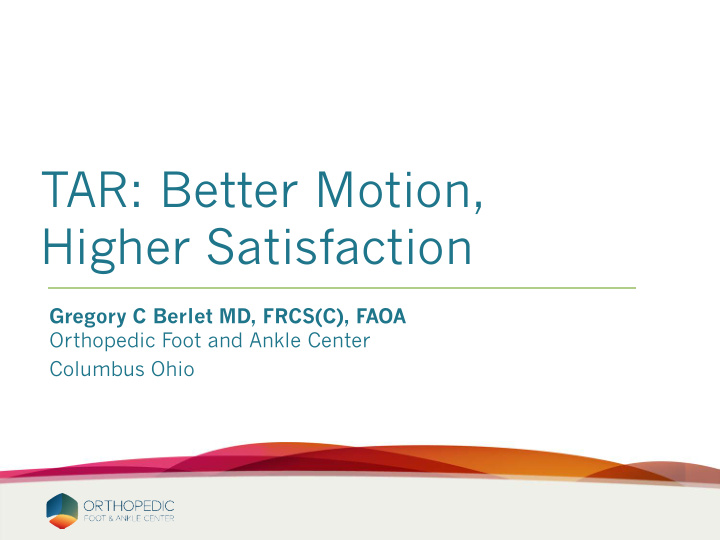



TAR: Better Motion, Higher Satisfaction Gregory C Berlet MD, FRCS(C), FAOA Orthopedic Foot and Ankle Center Columbus Ohio
Disclosures • Consultant/Speaker Bureau/Royalties/ Stock: Wright Medical, Stryker, ZimmerBiomet, DJO, Plasmology 4 , Amniox Medical, United Orthopedic Group, Paragon 28, CrossRoads, Ossio
Advanced Arthritis Options: 2017 Goals: • Pain improvement • Functional improvement • Patient perception of wellness (PROMIS)
Times Are Changing
Why Evolve To Arthroplasty ? • Partly because the alternative has significant challenges – Surrounding joint arthritis • Partly because of negative patient perception of ankle fusion • Partly because patients want more than just pain relief – they want function, and I believe that this will be reflected in PROMIS scores
Patients Read Research Too ! • 3-dimensional gait analysis 1 yr postop • 14 fusions vs 14 TAR vs 14 controls • Conclusion: – Pts w/ TAR had: • Greater increases in walking velocity • Greater stride length • Greater cadence Flavin, Brodsky et al. FAI. 34(10) 2013
Motion after TAR (historic) Pyevich et al. – 36 at an average f/u of 4.8 years – Minimum of 10 ° Knecht et al. – 18 at an average f/u of 9 years – Minimum of 2 ° Pyevich MT et al. JBJS Am 80: 1998 Knecht SI et al JBJS Am 86 2004
Motion after TAR Maintained • Initial ROM achieved by TAR is maintained • Average motion of 23 ° ( 6.3% less than 10 ° ) – No change at 3, 6, 12 months, then yearly – 1-5 year f/u Lagaay PM et al. JFAS 49:2010
Motion after TAR ( contemporary) Hsu and Haddad: – 59 1 0 TAR with INBONE – Mean total ankle motion improved from 29 0 to 38 0 Hofmann et al – 81 Salto Talaris – Avg post op motion was 39.5 0 Hsu AR, Haddad SL. JBJS Am 97(3), 2015 Hofmann et al JBJS 98(24), 2016
TAR Can Improve Motion Wood et al. – Improvement of >10 of DF • 19% BPs, 18% STARs – Improvement of >10 of PF • 8% BPs, 17% STARS Wood PL et al. JBJS Br 91-B(1):2000
Motion Sparing vs Producing Brodsky et al (2017): • 76 TAR with > 1 year follow up • Pre and post operative gait analysis to evaluate sagittal range of motion Brodsky et al FAI 38(10), 2017
TAR is Motion Producing Findings: • Pre-operative motion predictive of better post-operative range of motion • Patients with stiff ankles pre-op had greater improvement in function as measured by multiple parameters Brodsky et al FAI 38(10), 2017
Ankle Fusion or Arthroplasty ? Jordan RW et al (2014): • Systematic review comparing management of ESAA • 4 studies selected: – Three were level III retrospective comparison – One was a level II prospective comparison study Jordan et al Adv Orthopedics 2014
Ankle Fusion or Arthroplasty ? 4 qualifying studies: 2 studies showed significant functional improvements in TAR 2 studies showed no difference • Conclusion: Insufficient evidence to support a decision between TAR and Fusion Jordan et al Adv Orthopedics 2014
COFAS Ankle Arthritis Staging Stage I: Isolated ESAA Stage II: ESAA with ankle valgus or varus <10 0 , instability or equinus Stage III: ESAA with tibial, hindfoot or midfoot deformity Stage IV: ESAA with subtalar, talonavicular or CC arthritis
TAR vs Ankle Fusion 4 yr follow up: • TAR/AF result in significant outcome improvement for all types of arthritis • Complex (Types 3&4) Fusions have somewhat worse outcomes than Non-Complex (Types 1&2) Fusions • In types 3 and 4 ESAA TAR outcomes are significantly better than ankle fusion COFAS Annual Meeting January 2017
Surrounding Joint Disease COFAS Stage IV ESAA: • Evolving evidence suggests that patients with surrounding joint disease ( COFAS type IV) do better with TAR than fusion COFAS Annual Meeting January 2017
Comparison of Treatment Outcomes of Arthrodesis and Two Generations of Total Ankle Replacement (2017) • Prospective cohort comparing outcomes in 273 consecutive patients treated for ankle arthritis with either arthrodesis or TAR between ‘05 –’11 Benich et al JBJS 99(21), 2017
Prospective: TAR vs AF Benich et al (2017): • Level II data • Sig improvement of most measured parameters in both fusion and TAR • Most improvement occurred over the first 6 months Benich et al JBJS 99(21), 2017
Scores Better in TAR Benich et al (2017): • Average improvement in MFA and SF36 was better for TAR than arthrodesis • Younger patients had more improvement than older • Newer generation TAR had better improvement than older generation Benich et al JBJS 99(21), 2017
SUMMARY TAR and Ankle Motion Wins • Average motion in TAR with 3 rd generation implants is around 40 0 • Patients want more than just pain relief they want function • Benich et al (2017) showed in a prospective level II study that TAR has better function and clinical scores
SUMMARY Ankle Motion and TAR • Ankle motion is not magic – You have to plan and work for it ! – What you have on the table is the best it is going to be • I quote normal ROM after TAR is 30 0 , modern generation implants closer to 40 0
THANK YOU
Recommend
More recommend